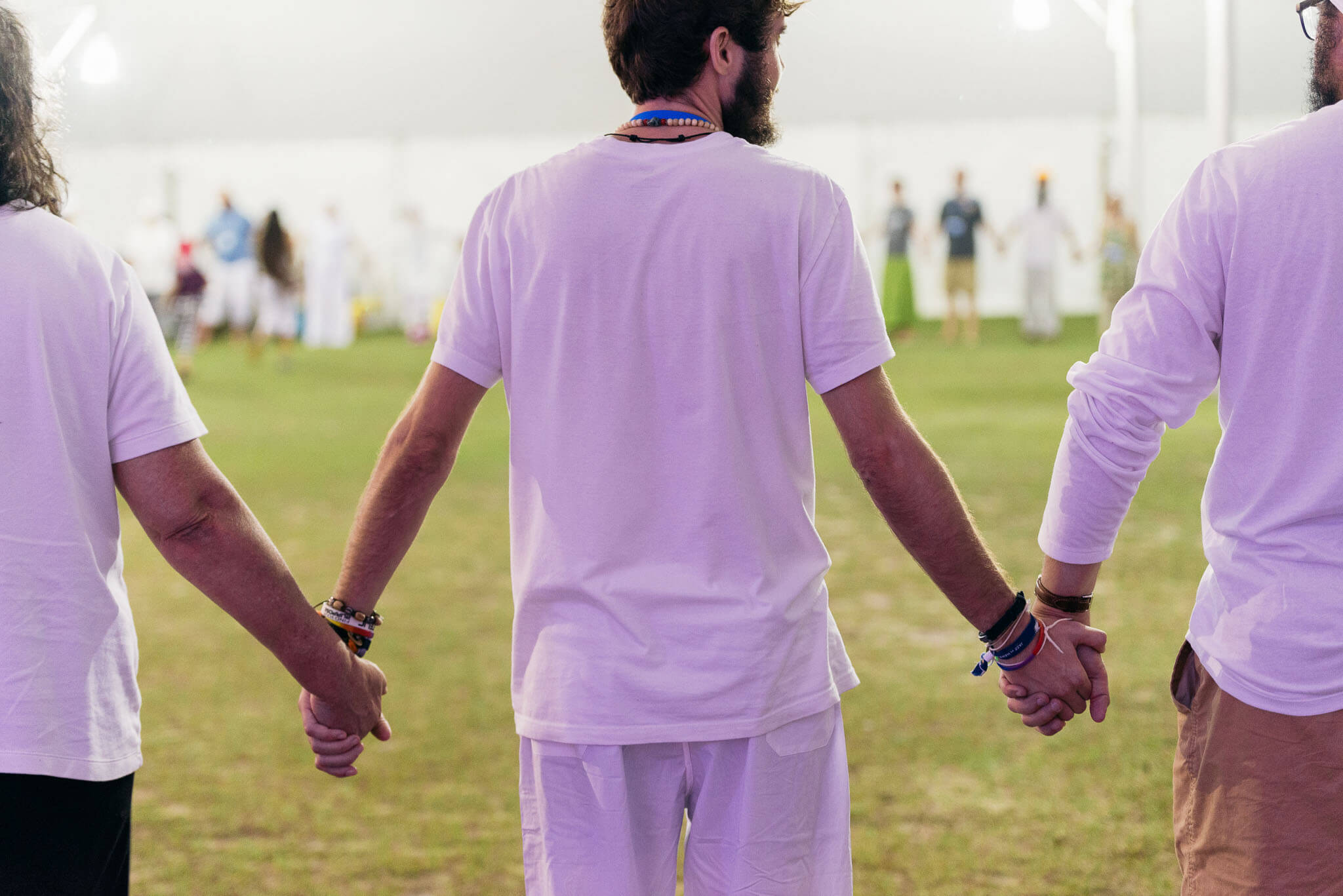A Handbook for Grief Recovery in Community
Loss, Grief and the Process of Change
This summary is gathered from 35 years of experience in serving people with a life-threatening illness and their families. Although some of what follows is from traditional grief therapy, most is from what Guru Gobind Singh (the 10th Sikh Guru) taught about loss from the example of his own life, and the tradition of Kundalini Yoga. Please add your own life experience to this information.
Loss is an experience that affects all aspects of who we are as a spiritual being in an earthly body, and must be integrated. One’s life is never the same after a loss. It is helpful to recognize and acknowledge that one is different from having gone through the experience and that this is a positive role grief plays in our lives. It is a spiritual experience if done consciously.
The yogic model of Grief Recovery is about the emerging of spirit, transformation, and the integration of change. The outcome is joy in the experience of aligning with one’s soul. With this as your focus, you will always be on target with yourself and in helping others.
Our intention with grief recovery is for the person to reflect on the loss, and feel complete, with a deeper understanding of one’s self and contentment for what is.
From Grief to Grief Recovery in Community
Grieving is one experience. Grief recovery is another. In conscious grief recovery, we recognize that we are fundamentally changed by the experience and integrate that change into a deeper revelation of our spirit, our true self.
This does not happen in isolation; it occurs in the context of our life, in community. Connection to community is what helps keep a person connected to life during loss. Neutral support and our own strong connection to spirit is how we can help others experiencing loss.
The Siri Guru Granth¹ has two hukams (directives): to chant the Naam and keep the company of the Holy. Transformation and integration of change take place internally within one’s self, and externally, in community. Both are necessary for a healthy and complete recovery from loss.
As teachers and leaders in community, we can facilitate this by creating environments where people talk together, eat together, play together, sing together, serve together. These practices are basic to our way of living as Kundalini Yogis and form the essence of grief recovery in community. In this time of COVID restrictions, we can create virtual ways of being together.

Grief is a Sword
Before his death, the writer Paul Monette described his experience of grief as a sword which cuts through any illusions about life and who we are. Like a spiritual sword, grief can take us directly through the pain of the mind and heart and lead us to the joy and infinity of the soul.
Grief Brings a State of Grace
Loss and the grief that accompanies it can be a gateway to the soul where something new can be born and the original purpose of the soul can unfold. This state of grace keeps the intellect minimal and the spirit open. This heightened awareness lasts about 2-3 weeks from the time of initial loss.
How we respond at the initial time of loss sets the tone for the whole recovery process. Be aware that 90 days is about the time it takes for most people to integrate the shock of the loss, and feel like they are in their body again.
Because so much internal change is occurring, it is recommended that major life decisions such as getting married, getting divorced, selling your assets, leaving a job, or moving are not made for at least a year following the initial loss.
Grief recovery is through the body, heart and soul. It is not an intellectual process. Grieving is a whole-body experience. Addressing emerging of spirit, transformation, and the integration of change through community, story, song, music, art, movement, play is quite helpful. Discussing, reasoning, and analyzing it is considerably less helpful.
As yogis we know that in every change there is loss and gain. Grief is a normal reaction to loss. During the initial phases of loss, the person is in an altered state. Some people even regress emotionally.
Normal Reactions to Loss Include:
- Instability; “falling apart”
- Loss of automatic pilot
- Loss of sense of control
- Challenge of deeply held beliefs
- Believe/feel loss didn’t happen
- Physical heaviness, tightness, chest, throat
- Empty feeling in stomach
- Loss of appetite and sleep disruption
- Difficulty concentrating, feel restless and unsatisfied
- Wander aimlessly, forgetful
- Feel the presence of what was lost (if what was lost is a person—through death, divorce or other separation—this presence is very real to the grieving person) loss of aliveness
- Guilt, anger, irritability (“This shouldn’t be happening”)
- Crying unexpectedly and for no apparent reason
- Isolation
- Frequent mood changes
- Need to take care of others or “keep busy” to deflect own pain
- Crisis of faith, questioning one’s own fundamental beliefs and assumptions
- Dismiss, minimize effect of loss (“It really isn’t so bad” or “I have no right to be so upset when others have lost so much.”)
- Need to tell and retell the story of the loss
- Act out uncharacteristic behavior (if continued or life-threatening call on professional help)
- Belief that if I were a more spiritual person, I wouldn’t be going through this
- Act like they are recovered so they, their family and their friends feel comfortable (“It’s OK, I’m over it.”)
What is lost? Self-concept, identity, the dream of the future, control, safety, relationship—any or all of these could be involved in the loss, not just the loved one, the job, the marriage etc. Identifying what is lost facilitates the grieving process and makes it more complete.
Has the person said goodbye? This is where spiritual traditions, ceremonies and rites are especially healing. They provide a way for a person to reach conclusion and to feel a deep connection through community and personal experience.
Grief recovery begins with the decision to integrate past experiences and move toward the future. This conscious decision is key.

The Grief Recovery Process
It may be months, even years, following the event of the loss before the cloud begins to lift and actual recovery begins. After the person has dealt with shock, the details of the initial loss (funeral arrangements, divorce settlement, etc.), and the emotional charge of feeling what had been numbed, recovery can begin.
Grief recovery is a series of conscious decisions and concrete tasks. Elizabeth Harper Neeld, Ph.D., author of Seven Choices, Taking the Steps to New Life After Losing Someone You Love (1990), describes seven distinct steps of the grieving process, each one requiring conscious involvement and decision.
The grieving person and her community has the task of:
- Moving from initial shock to feeling
- Finding meaning in the loss
- Clearing the past
- Restructuring their inner environment
- Regaining stability
- Making sense of the present
- Opening up to a new future
The person and her community move from:
- Instability to stability.
- Isolation to connection
- Emotions to meaning
- This leads to a renewed commitment from a deeper place in one’s self.
The grieving person will need a balance of solitude and sangat (community):
Space and supportive connection are very helpful. There are no hard rules for how to provide this. Keep your heart open, your patience and presence in tact, and listen to your intuition.
Grief is like water, it has to move or it stagnates: create situations for this movement, especially opportunities for chanting and singing and yoga. Nothing identifies, releases, or transforms emotional pain as quickly or completely as mantra.
In addition, our traditional songs help form an internal belief system that invokes our courage and essence of self. For example, the song, “Walking up the Mountain” is about conscious death.
Avoid rushing the recovery:
The person in loss is in a crisis of sell-trust. Their automatic assumptions about life, its meaning, and who they are in the world are shattered. They are in the process of making new assumptions and new decisions. The person must dive deeper than ever before to do this and in the process may question everything. They need to find their own answers. Help them, with your sense of peace.
Grief recovery is complete when the person:
- Can think about the loss without strong emotions of longing or sadness
- Can observe loss realistically (not in extremes of ideal or as terrible)
- Has found meaning or understanding of the experience
- Is not stuck in the past
- Lives in the present
- Is making plans for the future
- Feels comfortable in their body
- Is able to express joy

Some Complications to Grief Recovery
These may require professional help to resolve:
- Belief that life is not worth living without whatever was lost; thoughts of suicide
- Prolonged depression; unresolved anger; survivor guilt
- The need to make amends
- Difficulty forgiving; regretting the past
- Burying feelings; grieving alone
- Anniversary reactions
- Being too quick to replace what was lost
- Loss of trust of God, the universe, etc.
- Over protecting one’s self (“I can’t risk being open to life, I will lose again”)
- Inappropriate, uncharacteristic acting out behavior
- Loss experienced as trauma: multiple, progressive and catastrophic loss
Yogic Techniques to Deal with Grief
Nothing is more effective in transforming emotional pain than the Shabad Guru. Bring people together around the sound current of the Nam in creative and spirited ways, through mantra, kirtan, Akhand Paths, singing songs, telling stories and the like. Some ideas include:
- Reading from Peace Lagoon or Siri Guru Granth Sahib
- Chanting or playing any mantra or shabad is helpful, all relate to connection to the Infinite. Aap Sahaee Hoa and Guru Guru Wahe Guru, Guru Ram Das Guru are excellent mantras for grief release; Miter Piare Noon by Guru Gobind Singh is excellent for the resolution of loss.
- Please refer to Psyche of the Golden Shield or Psyche of the Soul for further information on the effects of the Banis and various shabads.
- Meditations and Yoga sets for Anger, Grief, and Fear, and Lungs and/or Lymphatic kriyas to release grief and stay well are helpful.
Take Care of Yourself
Serving persons in grief recovery often brings up our own unresolved grief. It is helpful to become aware of your own feelings about death, loss, soul, and purpose and to include these practices for yourself. Meditate, chant, swim, or otherwise be in water, write in a journal, read from the Siri Guru Granth Sahib. Laugh and talk with others for support. Get professional help if you need it.

The Process of Grief Recovery in Community Includes:
- Creating stability. This can be done through routine, continuity, communication.
- Listening as others tell their story: what happened and how they felt about it; by so doing, we create a context for meaning
- Making a public presence with boards of photos, poems, artwork, drawings, news clippings, hukams
- Making a memorial/a living remembrance as a community
- Presence of the family, and personal expression of condolences
- Eating together
- Chanting together
- Playing music and singing together
- Serving together/doing something tangible that benefits the community
- Praying together
- Meditating together
- Doing sadhana together
- Hosting or participating in an Akhand Path or Sahej Path
- Comforting each other
- Laughing together
- Playing together
As a community we can get in touch and stay in touch. In ways that it is appropriate, move closer to the person who is in grief, bring people together. How we respond as teachers and leaders in the initial phase, sets the tone for the entire recovery process. From the beginning, be calm, compassionate, inclusive, supportive, kind, and clear in our communication.
¹ Revered as the living Guru for Sikhs, a volume containing the sacred words of many enlightened beings who wrote while in a state of union (yoga) with God.

Your experience is important!
Share your wisdom with others like you. Leave your comment below